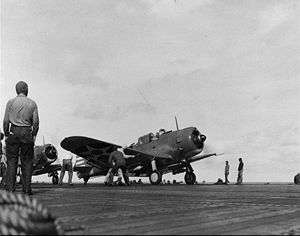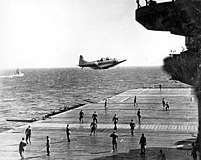Enterprise Air Group
The Enterprise Air Group was established on 1 July 1938, encompassing all squadrons embarked in USS Enterprise (CV-6). The group was divided into four squadrons, each with eighteen aircraft dedicated to a particular role. The squadrons were designated according to their role, and all were given the unit number six, derived from the hull number of the Enterprise. Bombing Six (VB-6) was equipped with Douglas SBD-2 Dauntless dive bombers, Fighting Six (VF-6) with Grumman F4F-3 Wildcat fighters, and Torpedo Six (VT-6) with Douglas TBD Devastator torpedo bombers. The fourth squadron, Scouting Six (VS-6) also had the SBD-2 Dauntless, but was more focused on the scout bomber role. This air group was embarked on board the Yorktown-class aircraft carrier USS Enterprise (CV-6) at the time of the attack on Pearl Harbor.[1]
| Enterprise Air Group | |
|---|---|
| Active | 1 July 1938 – 1 September 1942 |
| Country | United States |
| Branch | United States Navy |
| Type | Carrier air wing |
| Engagements | World War II • Pearl Harbor • Doolittle Raid • Battle of Midway • Battle of the Eastern Solomons |
| Decorations | Presidential Unit Citation (1943) |
WWII
Operations during WWII
| World War II operations by Enterprise Air Group | ||||||
|---|---|---|---|---|---|---|
| Period | Aircraft carrier | Operations | Squadrons | |||
| Fighter | Bomber | Torpedo | Scout | |||
| 7 December 1941 – 10 March 1942 | USS Enterprise (CV-6) (Task Force 16) | Pearl Harbor, Marshall Islands, Wake Island, Marcus Island | VF-6 | VB-6 | VT-6 | VS-6 |
| 8 April 1942 – 26 April 1942 | USS Enterprise (CV-6) (Task Force 16) | Doolittle Raid | VF-6 | VB-6 | VT-6 | VS-6 |
| 30 April 1942 – 26 May 1942 | USS Enterprise (CV-6) (Task Force 16) | Efate Island | VF-6 | VB-6 | VT-6 | VS-6 |
| 28 May 1942 – 13 June 1942 | USS Enterprise (CV-6) (Task Force 16) | Battle of Midway | VF-6 | VB-6 | VT-6 | VS-6 |
| 15 July 1942 – 25 August 1942 | USS Enterprise (CV-6) (Task Force 16) | Guadalcanal Campaign, Battle of the Eastern Solomons | VF-6 | VB-6 | VT-3 | VS-5 |
On 7 December 1941, eighteen SBD Dauntless scout bombers of squadrons VS-6 and VB-6 arrived over Pearl Harbor during the attack and, although surprised, immediately went into action in defense of the naval base. Scouting Six lost six planes during the attack, and Bombing Six lost one, killing eight airmen and wounding two others. Later that evening, six VF-6 Wildcats attempted to land at Ford Island, but five were accidentally shot down by friendly anti-aircraft fire, killing three pilots and wounding two others.[2][3][4] Enterprise’s air group carried out search missions to locate the Japanese carrier task force that attacked Pearl Harbor, but was unable to locate that force. Enterprise aircraft did sink a Japanese submarine on 10 December, but was unable to relieve the U.S. Marine garrison on Wake Island which fell to the Japanese.[5]
The Enterprise’s air group launched air strikes against Japanese shipping and military installations on Marshall and Gilbert island groups on 1 February 1942, followed by air raids on Wake Island on 24 February and Marcus Island on 4 March.[6] Enterprise’s air group provided air cover for the Task Force 16 which launched the Doolittle Raid from the carrier Hornet (CV-8) on 18 April.[7] This mission prevented Enterprise and Hornet from participating in the Battle of Coral Sea which saw the Lexington (CV-2) sunk and the Yorktown (CV-5) heavily damaged.[8]
Battle of Midway
The Battle of Midway was the climatic naval battle in 1942, with the Enterprise’s air group sinking the Japanese carriers Kaga and Akagi and contributing to the sinking of Hiryū.[9] Torpedo Six (VT-6) lost ten TBD-1, Bombing Six (VB-6) lost eleven SBD-3, Scouting Six (VS-6) lost nine SBD-3, and Fighting Six (VF-6) lost an F4F-4.[10][11]
During the battle, then-Lieutenant Commander Wade McClusky, leading the Air Group, made a critical tactical decision that led to the sinking of two of Japan's fleet carriers, Kaga, and Akagi. When McClusky could not find the Japanese carriers where he expected them, and with his air group's fuel running dangerously low, he spotted the Japanese destroyer Arashi steaming north at flank speed. (The Arashi had stayed behind to attack the USS Nautilus, which had been harassing the Japanese fleet.) Taking the Arashi's heading led him directly to the enemy carriers. He then directed his dive-bombers into an attack which led to the destruction of both Kaga and Akagi.
Guadalcanal
The Enterprise Air Group participated in the initial stages of the Guadalcanal Campaign, flying sorties in support of the invasions of Tulagi and Guadalcanal and performing CAP and antisubmarine patrols for the amphibious shipping in the area. The Air Group fought in the Battle of the Eastern Solomons on 24 August 1942, which was a strategic and tactical victory that blunted the Japanese counteroffensive during Guadalcanal Campaign.[12] When the Enterprise was damaged during the battle, elements of the Air Group were transferred to Henderson field at Guadalcanal, where they continued to fly in support of the invasion until their supply of aircraft was depleted.[13]
Disestablishment and Legacy
After returning to Pearl Harbor, the Enterprise Air Group was disestablished on 1 September 1942 after which in accordance with the Navy's new air group designation scheme of assigning numbers rather the name of the ship to which the group was assigned, a new air group designated Carrier Air Group SIX was established in March 1943 and assigned to Enterprise.[1] Due to the manner in which the United States Navy determines unit lineage, in which a unit's lineage begins at establishment and ends at disestablishment, the Enterprise Air Group and Carrier Air Group SIX are two separate and distinct units and do not share a lineage.[14]
 Marshall Islands Raid, February 1942
Marshall Islands Raid, February 1942 Doolittle Raid, May 1942
Doolittle Raid, May 1942_on_4_June_1942_(80-G-41686).jpg) Battle of Midway, June 1942
Battle of Midway, June 1942_and_USS_Saratoga_(CV-3)_on_19_December_1942.jpg) Off Guadalcanal, December 1942
Off Guadalcanal, December 1942
Awards and Commendations
Presidential Unit Citation
![]()
For consistently outstanding performance and distinguished achievement during repeated action against enemy Japanese forces in the Pacific war area, 7 December 1941, to 15 November 1942. Participating in nearly every major carrier engagement in the first year of the war, the Enterprise and her air group, exclusive of far-flung destruction of hostile shore installations throughout the battle area, did sink or damage on her own a total of 35 Japanese vessels and shoot down a total of 185 Japanese aircraft. Her aggressive spirit and superb combat efficiency are fitting tribute to the officers and men who so gallantly established her as an ahead bulwark in the defense of the American nation.[15]
References
- "Air Groups". USS Enterprise CV-6 Association. Retrieved 5 September 2008.
- "Enterprise Air Group, Report for Pearl Harbor Attack". Naval Historical Center. Archived from the original on 25 September 2008. Retrieved 5 September 2008.
- "Scouting Squadron Six Report of Action with Japanese at Oahu on 7 December 1941". ibiblio. Retrieved 5 September 2008.
- "Pearl Harbor — 7 December 1941". USS Enterprise CV-6 Association. Retrieved 5 September 2008.
- "1941". USS Enterprise CV-6 Association. Retrieved 5 September 2008.
- "Action Report — 1 February 1942". USS Enterprise CV-6 Association. Retrieved 5 September 2008.
- "Doolittle Raid". USS Enterprise CV-6 Association. Retrieved 5 September 2008.
- "1942". USS Enterprise CV-6 Association. Retrieved 5 September 2008.
- "Battle of Midway". USS Enterprise CV-6 Association. Retrieved 5 September 2008.; "Action Report Serial 0137". USS Enterprise CV-6 Association. Retrieved 5 September 2008.
- "Action Report Serial 0133". USS Enterprise CV-6 Association. Retrieved 5 September 2008.
- "Action Report Serial 0137". USS Enterprise CV-6 Association. Retrieved 5 September 2008.
- "Battle of the Eastern Solomons". USS Enterprise CV-6 Association. Retrieved 5 September 2008.
- Stafford, Edward P., The Big E: The Story of the USS Enterprise.
- Grossnick, Roy A. United States Naval Aviation 1910-1920 Volume II Statistics. Naval History and Heritage Command.
- "Presidential Unit Citation". USS Enterprise CV-6 Association. Retrieved 28 September 2008.